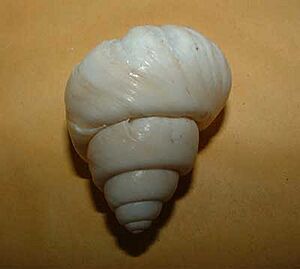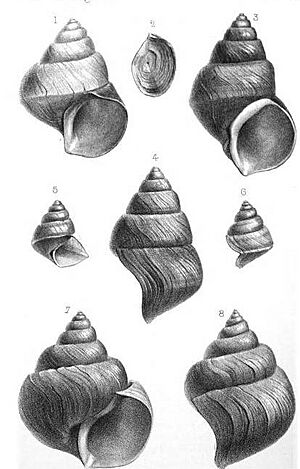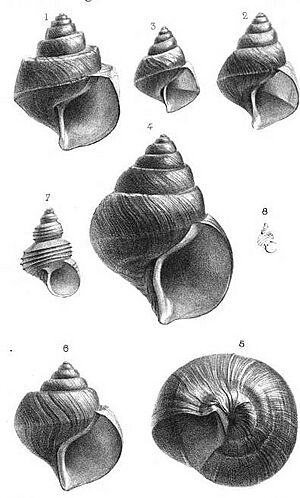Neothauma facts for kids
Quick facts for kids Neothauma |
|
|---|---|
 |
|
| shell of Neothauma tanganyicense | |
| Conservation status | |
| Scientific classification |
|
| Kingdom: | Animalia |
| Phylum: | Mollusca |
| Class: | Gastropoda |
| Subclass: | Caenogastropoda |
| Order: | Architaenioglossa |
| Superfamily: | Viviparoidea |
| Family: | Viviparidae |
| Genus: | Neothauma E. A. Smith, 1880 |
| Type species | |
| Neothauma tanganyicense E. A. Smith, 1880 |
|
| Synonyms | |
|
Viviparus (Neothauma) E. A. Smith, 1880 |
|
Neothauma is a genus of freshwater snail with a gill and an operculum, an aquatic gastropod mollusc in the subfamily Bellamyinae of the family Viviparidae.
Contents
Species
- Neothauma jouberti Bourguignat, 1888
- † Neothauma jupadwongaensis Musalizi, 2017
- Neothauma tanganyicense E. A. Smith, 1880
- Taxa inquirenda
- Neothauma bridouxianum Grandidier, 1885
- Neothauma servainianum Grandidier, 1885
- Species brought into synonymy
- Neothauma bicarinatum Bourguignat, 1885: synonym of Neothauma tanganyicense var. bicarinatum Bourguignat, 1885
- Neothauma ecclesi Pain & Crowley, 1964: synonym of Bellamya ecclesi (Crowley & Pain, 1964) (original combination)
- Neothauma giraudi Bourguignat, 1885: synonym of Neothauma tanganyicense E. A. Smith, 1880 (junior synonym)
Distribution
This freshwater snail is only found in Lake Tanganyika, where it is the largest gastropod, and occurs in all four of the bordering countries — Burundi, the Democratic Republic of the Congo, Tanzania, and Zambia — although fossil shells have been discovered at Lake Edward and in the Lake Albert basin.
The type locality is the East shore of Lake Tanganyika, at Ujiji.
History
The genus Neothauma previously contained several species, but most were reassigned to other genera.
Description
The width of the shell is 46 mm (1.8 in). The height of the shell is 60 mm (2.4 in).
Ecology
This species lives in depths of up to 65 m (213 ft). There is conflicting information relating to its feeding behavior, with one study referring to it as a detritus-feeder, another saying that it actively preys on endobenthic organisms, and finally that it feeds on particulate organic filtered while the snail is buried.
The shells of dead Neothauma tanganyicense often form carpets over large areas, and are used by a number of other animals, such as cichlid fish (shell dwellers), and freshwater crabs of the genus Platythelphusa. Juvenile snails live in the sediment in order to avoid predators.




